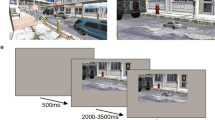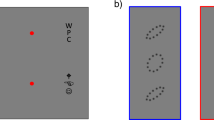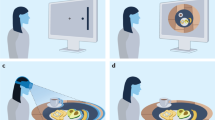Abstract
How do we detect a target in a cluttered environment? Here we present neuropsychological evidence that detection can be based on the action afforded by a target. A patient showing symptoms of unilateral neglect following damage to the right fronto-temporal-parietal region was slow and sometimes unable to find targets when they were defined by their name or even by a salient visual property (such as their color). In contrast, he was relatively efficient at finding a target defined by the action it afforded. Two other patients with neglect showed an opposite pattern; they were better at finding a target defined by its name. The data suggest that affordances can be effective even when a brain lesion limits the use of other properties in search tasks. The findings give evidence for a direct pragmatic route from vision to action in the brain.
This is a preview of subscription content, access via your institution
Access options
Subscribe to this journal
Receive 12 print issues and online access
$209.00 per year
only $17.42 per issue
Buy this article
- Purchase on Springer Link
- Instant access to full article PDF
Prices may be subject to local taxes which are calculated during checkout





Similar content being viewed by others
References
Chelazzi, L., Miller, E. K., Duncan, J. & Desimone, R. A neural basis for visual search in inferior temporal cortex. Nature 363, 345–347 (1993).
Duncan, J. & Humphreys, G. W. Visual search and stimulus similarity. Psych. Rev. 96, 433–458 (1989).
Wolfe, J. M. Guided search 2.0: a revised model of visual search. Psych. Bull. Rev. 1, 202–238 (1994).
Humphreys, G. W. & Muller, H. M. SEarch via Recursive Rejection (SERR): A connectionist model of visual search. Cognit. Psych. 25, 43–110 (1993).
Humphreys, G. W. & Heinke, D. Spatial representation and selection in the brain: neuropsychological and computational constraints. Vis. Cognit. 5, 9–48 (1998).
Gibson, J. J. The Ecological Approach to Perception (Houghton Mifflin, Boston, 1979).
Gado, M., Hanaway, J. & Frank, R. Functional anatomy of the cerebral cortex by computed tomography. J. Comput. Assist. Tomogr. 3, 1–19 (1979).
Robertson, I. H. & Manley, T. in Attention, Space and Action: Studies in Cognitive Neuroscience (eds. Humphreys, G. W., Duncan, J. & Treisman, A.) 297–310 (Oxford Univ. Press, Oxford, 1999).
Rumiati, R. I. & Humphreys, G. W. Recognition by action: dissociating visual and semantic routes to action in normal observers. J. Exp. Psychol. Hum. Percept. Perform. 24, 631–647 (1998).
Miller, E. K. in Attention, Space and Action: Studies in Cognitive Neuroscience (eds. Humphreys, G. W., Duncan, J. & Treisman, A.) 251–272 (Oxford Univ. Press, Oxford, 1999).
Hodges, J. R., Spatt, J. & Patterson, K. “What” and “how”: evidence for the dissociation of object knowledge and mechanical problem-solving skills in the human brain. Proc. Natl. Acad. Sci. USA 96, 9444–9448 (1999).
Driver, J. in Attention (ed. Pashler, H.) 279–310 (Taylor Francis, London, 1998).
Wilson, B., Cockburn, J. & Halligan, P. W. Behavioural Inattention Test (Thames Valley Test Company, Titchfield, Hants., 1987).
Edwards, M. G. & Humphreys, G. W. Pointing and grasping in unilateral visual neglect: effect of on-line visual feedback in grasping. Neuropsychologia 37, 959–973 (1999).
Warrington, E. K. & James, M. The VOSP Test of Visual Function (NFER, Berkshire, 1991).
Riddoch, M. J. & Humphreys, G. W. Birmingham Object Recognition Battery (BORB) (Psychology Press, London, 1993).
Balint, R. Seelenlahmung des “Schauens”: optische ataxie, raumliche Storung der Aufmerksamkeit. Monatschrift fur Neurologie und Psychiatrie 25, 51–81 (1909).
Hall, D., Humphreys, G. W. & Cooper, A. Reading using supra-letter units: Evidence from attentional dyslexia. Quart. J. Exp. Psychol. (in press).
Gilchrist, I., Humphreys, G. W. & Riddoch, M. J. Grouping and extinction: evidence for low-level modulation of selection. Cognit. Neuropsychol. 13, 1223–1256 (1996).
Shalev, L. & Humphreys, G. W. Biased attentional shifts associated with unilateral left neglect. Cognit. Neuropsychol. 17, 339–364 (2000).
Acknowledgements
This work was supported by grants from the MRC and the Wellcome Trust. We thank MP, MB and GK for their participation in these studies and V. Chavda for help with scan reconstruction.
Author information
Authors and Affiliations
Corresponding author
Rights and permissions
About this article
Cite this article
Humphreys, G., Jane Riddoch, M. Detection by action: neuropsychological evidence for action-defined templates in search. Nat Neurosci 4, 84–88 (2001). https://doi.org/10.1038/82940
Received:
Accepted:
Issue Date:
DOI: https://doi.org/10.1038/82940
This article is cited by
-
Does knowledge influence visual attention? A comparative analysis between archaeologists and naïve subjects during the exploration of Lower Palaeolithic tools
Archaeological and Anthropological Sciences (2022)
-
Precrastination and individual differences in working memory capacity
Psychological Research (2021)
-
Intelligent action guidance and the use of mixed representational formats
Synthese (2021)
-
Starting or finishing sooner? Sequencing preferences in object transfer tasks
Psychological Research (2019)
-
What Unilateral Visual Neglect Teaches us About Perceptual Phenomenology
Erkenntnis (2015)



